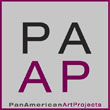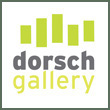« Reviews
Eduardo Hoffmann: Hermanos Videntes
Galeria Lordi Arte Contemporáneo - Buenos Aires
By Juan José Santos
The path of Eduardo Hoffmann (Mendoza, 1957) has been marked by a set of styles, trends and formats that goes from his interest in surrealism to his current incursion in figurative expressionism. Working with various materials, such as wood, resin or canvas, his technical mastery and ability to experiment with matter are very clear.
In the show “Hermanos videntes” (Brothers Seers), some of this detachment is latent. We can divide the exhibition into four territories. On one hand, we find monochromatic canvases with a totemic, iconic vocation, which refer to cave paintings; on the other, something like giant colorful badges that contain some reinterpretations of famous paintings in the history of art, such as Fusilamientos del tres de mayo, by Goya. Next to that work are others following the line of installation-paintings, a roll of painting of abstract motifs that can be moved like a blind. On another wall, the works have an absolutely contrary intent, and refer to the title of the exhibition. Hoffmann transforms and reduces the items that appear in Las Meninas by Velazquez to its name, so that on a large sheet of paper are written “painter,” “table” or “mirror.”
In another paper the conceptual game of words is translated into Braille, but according to their aesthetic weight, it does not appear in relief. In a third version at last, the Braille is embossed. Finally, in the middle of the room, the artist has installed a kind of “scalextric,” but with the cars replaced by electric chairs-a sick joke that led to a fairground attraction, or at least that was the idea of those who attended the opening of the exhibition when they decided to set up the chairs and turn down the runway. Obviously, the disconnection between the pieces, makes the viewer more aware of the total confusion evident.
It is hard to understand where the artist wants to take us. The remake of Las Meninas (which reminds me of some works in the 1970s by Marcel Broodthaers), in another context and another sense, could be interesting, but the mix of styles is as badly paired as chocolate and fish. Ultimately, some works are disturbing, while others are intoxicating.
The metaphysical little train reminds me of the works of Enrique Jezik, although he developed a better solution. And I definitely find more enjoyable the pop conversion of past works with the punk intention of Javier Arce, also using Francisco de Goya paintings. These works are the result of a failed exhibition curated by Hoffmann himself, who has fallen victim of inconsistency with fatal consequences. It is one thing to diversify styles and quite another to combine things that are diametrically opposed.
Both the title and the general concept of this show are inspired by the book Hermanos videntes. Escritos sobre arte, by Paul Eluard. Maybe because of this reason the epic intention behind this show sounds to me more typical of avant-garde’s age ambitions than of the drift of 21st century contemporary art.
(October 13 - November 24, 2011)
Filed Under: Reviews



































